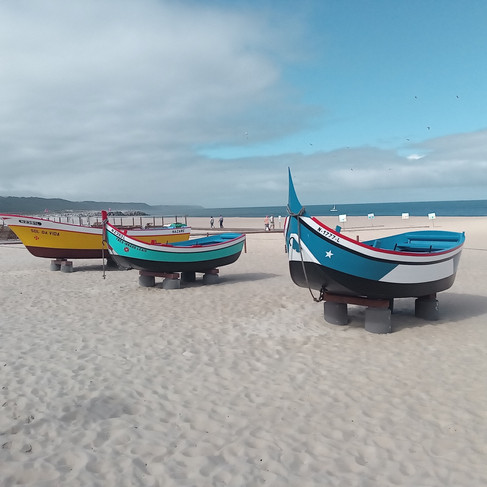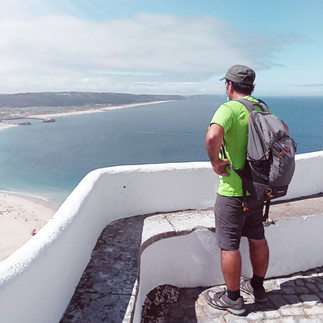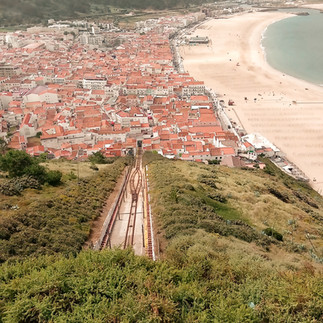Discovering the West - III
- Catarina Araújo

- Aug 28, 2021
- 11 min read
Updated: May 8
Nazaré

Our trip continued to the typical village of Nazaré. This old fishing village, which in the 20th century turned to tourism, a more traditional beach tourism, in recent years has attracted other types of tourists, surfers and photographers, surf and nature lovers who come to admire the strength of the sea. In this unique place, due to the Nazaré Canyon, waves of 30 meters are generated, being considered the best place in the world to observe giant waves.
When we arrived in Nazaré it was raining. We put on our covers and went to look for the PR1 NZR Route Miracles of Nazaré. First we passed by the Municipal Market and decided to enter. We love markets, watch the colors of the farmers' stalls, the homemade cakes and of course the fresh fish. Due to the appearance of large supermarkets, going to the market is no longer so frequent, but, fortunately, many people still have this habit. And this is where the freshest products are found. At the fish stand we found a very nice lady who was selling a very typical Nazaré snack: dried fish. It's mackerel and sardines, scaled and seasoned with olive oil, garlic and herbs. What a delight and only €5 a fish! We tasted this snack and when we went out into the street, it wasn't raining anymore!
In the urban center of Nazaré there were three old villages: Pederneira, Sítio da Nazaré and Praia da Nazaré. In the second half of the 20th century, new neighborhoods emerged.
The settlement of Nazaré began in the Pederneira area. The occupation of the Praia area is much more recent, and it was only possible with the retreat of the sea. In the area currently occupied by the houses there were dunes and, to the south, the mouth of the Alcoa river. Many people arrived in Nazaré looking for work opportunities related to fishing. In this area, sheltered by the promontory, the sea does not have the most violent waves that we can find in Praia do Norte, on the other side of the promontory.
The beach
The Arts of Fishing
In Nazaré we can find the oldest Portuguese traditions linked to the fishing arts. Did you know that many Nazarenes traveled to the North Seas for Cod Fishing?
The Xávega Art was a type of artisan fishing, in which the net was placed in the sea in various "shots". An hour and a half later, two lines of men and women pulled the ropes and dragged the bag across the sand.
Between 1995 and 2011, Nazaré Municipality, with the support of local fishermen, recreated the Xávega Art, between the months of May and June.
On the beach at Praia da Vila, we can find several examples of traditional fishing boats, and also a lifeboat that saved some fishermen from shipwrecks. Many other seamen lost their lives at sea. The old vessels were acquired and restored by Nazaré Municipality, in a protocol with Dr. Joaquim Manso Museum.
Some traditional boats such as "Nossa Senhora dos Aflitos", "Mimosa", "Perdido", "Vagos", "Ilda", "Três Irmãos Leais" and "Sol da Vida", were recovered by a naval carpenter technician and are now icons representing the county's identity and history, connected to the sea.
The Fish Drought
At Praia da Nazaré, in front of the Cultural Center of Nazaré, where the Fish Auction used to be, is the Peixe Seco Market (Dry Fish Market), where the women continue to dry the fish in baskets on a daily basis, which is essentially a female knowledge.
When fish was scarce, this activity ensured the families' sustenance. When there was an excess of fish, the fishmongers resorted to this art to conserve the fish.
There are two distinct products: dried fish and "seasick fish". After being prepared and salted, the fish is spread in "paneiros" - rectangular net trays - where it remains for about 2/3 days or only 3/4 hours in the case of the "seasick fish". The most used species are horse mackerel, batuques, petinga (small sardines) and dogfish.
In front of the Cultural Center you can find the Nazarene Mother Statue, a tribute to the women of Nazaré, who had a very hard life as they simultaneously dedicated themselves to fishing and their children, staying for long periods of time alone while their men were away at sea.
The Nazareno Costume is unique in Portugal: the women wore the famous seven skirts while they were waiting for their husbands and sons on the beach, and men wore the typical flannel shirt and black cap.

The sítio
Sítio it is an impressive promontory, 318m high and with several viewpoints to the bay of Nazaré. To go to the Sítio you can go on foot or take the Ascensor (elevator).
Suberco Viewpoint
This is the best known viewpoint in Nazaré, located on the Promontory.
Ladeira was an old sand path that served as a connection between the beach and the Sítio, which was paved to facilitate circulation. Until the construction of the elevator, this was the fastest way to the Sítio.
At Ladeira it was built the Panoramic Swing of Nazaré, overlooking the beach and the houses. Here you can also admire the Giant Wave Mural from the Brazilian artist Erick Wilson.

The installation of the mechanical elevator (the Ascensor), in 1889, contributed to the increase of the population of Sítio, which was more frequented by pilgrims and travelers. The Ascensor station is very appealing with the ceramic panel from the artist Mário Reis. In the upper station of the Ascensor, you can find more panels depicting the universe of Nazaré, from its traditions to surfing, created by this artist from Caldas, who was invited by Nazaré Municipality to perform Public Art.
The Worship of Our Lady of Nazaré
The history of Sítio is linked to the Cult of Our Lady of Nazaré and the legend of the Miracle of Nazaré. The 18th century Marian Cult is today a candidacy for Intangible Heritage of Humanity and has a great expression in Brazil.
The image of Our Lady of Nazaré is a Black Virgin, carved in wood, brought from Mérida by a monk who was fleeing from Muslim invaders. It was venerated in several shrines, first in a cave near the cliff, where the monk lived as a hermit. Then the image was taken to the Capela da Memória (Chapel of Memory), on the edge of the cliff above the cave, built by D. Fuas Roupinho in gratitude to the Virgin for having saved his life.
According to legend, D. Fuas Roupinho, mayor of Porto de Mós Castle, used to hunt in the region. On a very foggy morning in 1182, the mayor was chasing a deer when he saw it disappear over the precipice. Frightened by the emergence of his fall, he asked the virgin for help and the horse stopped immediately, saving his life.
Today, the image of Our Lady of Nazaré is on the altar of Our Lady of Nazaré Sanctuary and attracts large pilgrimages on September the 8th. This Sanctuary was founded by King Fernando in 1377. In the 17th century it was rebuilt and its medieval origins are hardly recognizable today. It has a very spacious yard to accommodate pilgrims and, on the sides, are the Hospital building and the Old Royal Palace.
The Wave of Praia do Norte
The waves of Nazaré became world famous thanks to the World Record for the biggest wave ever surfed, of 30 meters, which was established by Garret McNamara, in Praia do Norte, in November 2011. Nowadays, Nazaré is the stage for the biggest world Surfing championships.
These giant waves are possible due to the existence of the Nazaré submarine canyon, which modifies the behavior and structure of the waves. The waves travel faster in the canyon and, when they reach the beach, the depth is reduced, the wave makes a blister and amplifies its height.
The Nazaré Canyon is the largest submerged canyon in Europe, with a depth of 5000 meters. At the end of World War II, a German submarine was sunk in the Nazaré Canyon.
The big waves season in Nazaré is between October and March, but it's always good to check the forecasts on the windguru website. On nazarewaves.com you can subscribe the notifications and be notified whenever there are good conditions for giant waves in Nazaré.
The best place to watch the waves is at São Miguel Arcanjo Fort, next to the Lighthouse. On the way to the Fort we find the Statue Homage to Surfers and Our Lady of Nazaré- "O Veado" (The Deer), designed by Agostinho Pires and made by the sculptor Adélia Alberta. In the anthropomorphic sculpture of the deer surfer, the two themes of the history of Nazaré are brought together: the legend of the deer and Our Lady of Nazaré and the surfers of the giant waves of Nazaré.
Fort of São Miguel Arcanjo
The Fort of São Miguel Arcanjo (Saint Michael Archangel), Mannerist style, was built in 1577, during the reign of D. Sebastião, to defend the inlet from pirate attacks. In 1644, during the reign of D. João, it was rebuilt and expanded. The limestone image of Saint Michael Archangel, protector of the Fort, has an inscription with this date.
During the French Invasions, the troops took refuge in the fort and fought against the local populations of Sítio and Pederneira. The peoples of the land fought for their freedom and to drive out the invaders and many perished.
Later, the Fort was also the scene of liberal struggles. Around this time, the image of the Saint suffered a serious attack by the liberals who sent it down the walls to the beach. It is still mutilated today.
In the 20th century, fishermen asked the government to build a lighthouse and a house for the lighthouse keeper to support fishing activities.
At São Miguel Arcanjo Fort you can also visit the Interpretive Center of Nazaré's Canyon and the Surfer Wall.
The Interpretive Center of Nazaré's Canyon contains scientific information carried out by the Hydrographic Institute and a model of the Nazaré's Canyon.
Surfer Wall is a museological project created in 2016 with an exhibition of boards offered by surfers to Nazaré with a short biography of each one of them.
Next to the Wall there's an installation of seagulls, from the artist Mário Reis, which nowadays belongs to the Fort's estate.
The Forno da Orca Cave
At Praia do Norte, hidden at the base of the promontory in the southern end of the beach, there is a limestone cave with a typical furnace of marine erosion, the Forno da Orca (Orca's Oven). When the tide is low and the sea is calm, it is possible to visit the interior of the cave. If it is a rough sea day and with high tide, the sea enters the cave violently .
Aguieira Dune
The Aguieira Dune was considered the largest consolidated dune in Europe. It belongs to a sedimentary complex of dunes and sands in the North of Nazaré and reaches a width of 6 km. The preservation of this structure, which resists to erosion, is related to the planting of Pinhal de Leiria (Leiria's Pine Forest).
In the vicinity of Nazaré, there is an extensive pine forest, which belongs to the Pinhal de Leiria. At the Pinhal da Casa de Nossa Senhora da Nazaré (Pine forest of the House of Our Lady of Nazaré), there is also a picnic area and a children's playground. In this pine forest live a group of deer - fallow deer and deer - which were offered by the General Directorate of Forest Resources, in a project that aimed to repopulate the pine forest with some species that already existed in the area and, also, as an evocation of the legend of the Miracle of Nazaré .
The huge Leiria's pine forest was planted by King D. Afonso III, expanded by King D. Dinis, the "The Farmer King"and became known as the King's Pine Forest. It was for centuries, the lung of Portugal, because for every tree cuted, one was planted. During the Discoveries, caravels and other vessels were built with wood from this pine forest.
Resining is the process of extracting resin from pine trees and is done mainly on the central coast of the country. To access the resin, cuts must be made in the bark of the pine tree trunk. Then, containers are affixed to the trunk to collect a released substance for about 15 days until the wound closes and, eventually, a new cut is made. There is a more intensive form of exploration, the "resining to death", in which many cuts are made in the tree. By law this type of extraction is only allowed in the 4 years prior to the felling of the tree.
We pass by Caminho da Nazaré (Path of Nazaré), towards Fátima. This path is 50 km long, is made in two stages and joins two important sanctuaries linked to the Marian Cult.
In this part of the route, which we followed on the GPS, the route crosses, at two points, new expressways that were built after marking the route. For this reason, and because the marking of the route has not been maintained for many years, as it seems to us, we do not recommend this route.
São Bartolomeu Hill
In the middle of a dune landscape covered by the Leira's pine forest, there is an island of Mediterranean flora, in São Bartolomeu Hill, a classified place since 1979, where species such as oak, carrasco, aderno and strawberry tree grow, and some animals live, for example, the genet. This elevation of magmatic origin is 156m high at its summit.
At the top, between large boulders, stands the Chapel of S. Brás and São Bartolomeu, which used to be part of an old hermitage. You can find a surveillance post of the forest guard on this elevation.
For centuries, on the 3rd of February, the day of São Brás, the population of Nazaré makes a pilgrimage to the hill to celebrate the date.
Unfortunately, we founded the place with a lot of garbage in the nearby caves, and some felled trees on the way to the east.
Pederneira
Pederneira Viewpoint
Located next to Misericórdia Church, this natural viewpoint offers a panoramic view of the green area of Pinhal de Leiria, the coastline, Sítio and the houses of Nazaré.
The Pederneira Pillory
At Bastião Fernandes Square, next to the building of the old Town Hall and the Mother Church of Nossa Senhora das Areias (Our Lady of the Sands), we find this intriguing pillory. For those who pass by, it may go unnoticed, but it is a fossilized trunk of a coniferous tree dating from the Cretaceous period. The trunk was placed on the base of the old pillory that had disappeared. The reasons that led to the disappearance of the old pillory are not known, but it is believed that the choice of the trunk for replacement is linked to a pre-Christian Marian Cult, which left many marks in our popular culture, a phenomenon known as Phytolatry, in those centuries-old trees were placed in churchyards and next to monuments.
Joana de Castro Rodrigues and Carlos Neto de Carvalho, in their article "The Fossil Trees of Vila Velha de Rodão: Contribution to their Conservation and Valorization as Geomonuments" emphasize the importance of the conservation of these fossils and their recognition as Geomonuments and state that the Pederneira Pillory is a fragment of a fossil trunk of a conifer and "the first fossil to be protected by law in Portugal, occupying the place of the ancient symbol of local power since 1886", in addition to being "the only specimen in the world in which a fossil was used directly as a popular symbol of local sovereignty."
Pedralva Garden
Descending from Pederneira towards Nazaré, we pass the Hermitage of Nossa Senhora dos Anjos (Our Lady of the Angels) and the Pedralva Garden.
The Pedralva Garden has this name because it was built around Monte Branco (White Hill), not that of the Pyrenees, but a set of rocky outcrops in white tones due to the white clay that makes up the rocks. It is a natural viewpoint that provides a panoramic view over Nazaré and its surroundings.
The garden has a lake and other leisure facilities, as well as a set of garden benches with tiles from the 1930s. In this park you can find various botanical species, both ornamental and native. Some ornamental plants are exotic and come from distant parts of the world.




















































Comments